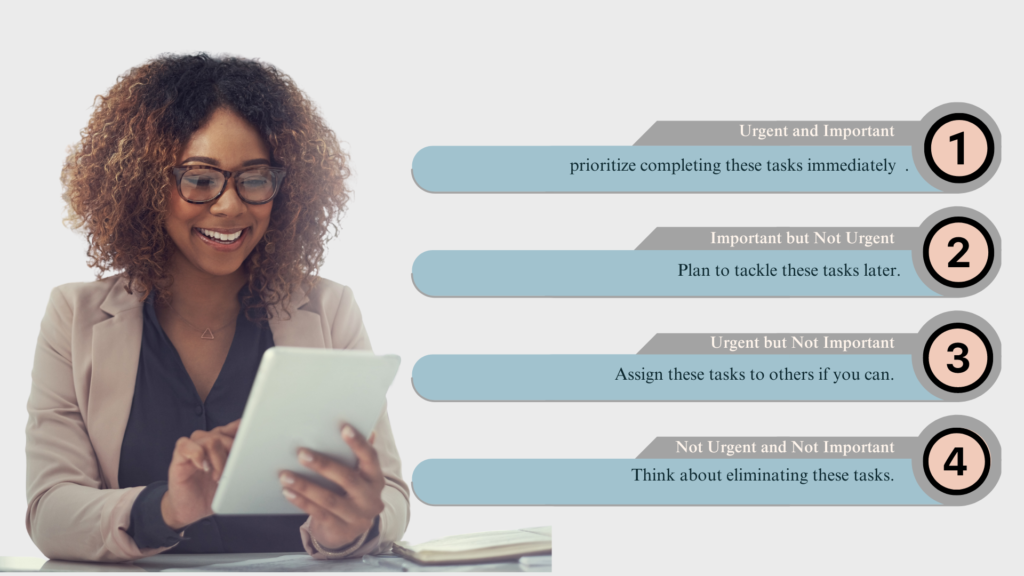Navigating the corporate grind often feels like running a marathon with back-to-back meetings, endless emails, and looming deadlines. However, with a few strategic approaches, you can Maximize Productivity, alleviate stress, and carve out moments to breathe. Here are ten practical tips to optimize your workday.
1. Set Clear Goals

Imagine starting your day with a clear roadmap. Doesn’t that sound better than just diving into the chaos? Set clear, specific goals for what you want to achieve. Break larger goals into smaller, manageable tasks. For example, if your goal is to launch a new project, break it down into steps like “complete project proposal by Friday” or “schedule kick-off meeting next Wednesday.” Keep your goals SMART (Specific, Measurable, Achievable, Relevant, Time-bound) so you know exactly what you’re working towards and can track your progress.
2. Prioritize Tasks

Not all tasks are created equal. It’s easy to get bogged down in busywork and miss the big picture. Use the Eisenhower Matrix to prioritize:
• Urgent and Important: Prioritize completing these tasks immediately.
• Important but Not Urgent: Plan to tackle these tasks later.
• Urgent but Not Important: Assign these tasks to others if you can.
• Not Urgent and Not Important: Think about eliminating these tasks.
For instance, if you’ve got a client presentation next week (Important but Not Urgent), start preparing for it now instead of getting lost in minor tasks like organizing your email inbox (Urgent but Not Important).
3. Create a Daily Schedule
Start each day with a plan. Before you log off each evening, take a few minutes to outline your tasks for the next day. Set aside designated time periods for each task, including time for breaks. Use tools like Microsoft Outlook or Google Calendar to set reminders for meetings and deadlines. Incorporate buffer times between tasks to handle unexpected issues and avoid feeling rushed.
4. Avoid Multitasking
Multitasking might feel productive, but it can actually reduce efficiency and increase errors. Concentrate on tackling one task at a time instead. Techniques like the Pomodoro Technique can help—work for 25 minutes on a single task, then take a 5-minute break. This can improve concentration and reduce fatigue, allowing you to complete tasks more effectively.
5. Take Regular Breaks
Regular breaks are essential to maintaining productivity and avoiding burnout. Use short breaks to stretch, walk around, or grab a coffee. The Pomodoro Technique is particularly effective in a corporate setting: work for 25 minutes, then take a 5-minute break. Following four sessions, allow yourself a more extended break ranging from 15 to 30 minutes. These breaks can help clear your mind and boost your focus when you return to work.
6. Minimize Distractions
Distractions in the office are inevitable, but you can minimize them. Here’s how:
- Digital Distractions: Digital Distractions: Disable unnecessary alerts on your phone and computer. Use apps like Focus@Will to play concentration music.
- Work Environment: Maintain an orderly and clutter-free workspace. Noise-cancelling headphones are effective in eliminating background noise.
- People: Politely let colleagues know when you’re in focus mode by setting a “Do Not Disturb” status on your messaging apps or using a desk sign.
7. Use Productivity Tools
There are many tools available to help streamline your work. Here are a few recommendations:

- Task Management: Use tools like Trello, Asana, or Microsoft Planner to organize and track tasks.
- Note-Taking: Evernote or OneNote can help you capture and organize ideas and meeting notes.
- Time Management: Use Toggl to track how you spend your time and identify areas for improvement.
- Communication: Slack or Microsoft Teams can facilitate efficient communication with your team.
Try out various tools to discover what enhances your workflow the most.
8. Practice Time Management
Effective time management is crucial in the corporate world. Time blocking is a powerful technique: allocate specific blocks of time for different activities, such as deep work, emails, and meetings. For example, dedicate 9-11 AM to deep work, 11-12 PM for responding to emails, and 1-3 PM for meetings. This structure helps you stay focused and ensures you’re making time for all your priorities.
9. Focus on Your Health
Your productivity is closely tied to your physical and mental well-being. Here are a few tips:

- Sleep: Aim for 7-9 hours of quality sleep each night to improve focus and decision-making.
- Nutrition: Maintain a balanced diet, stay hydrated, and avoid too much caffeine.
- Exercise: Regular physical activity boosts energy levels and reduces stress. Taking a brief walk during your lunch break can have a positive impact.
- Mental Health: Practice mindfulness or meditation to reduce stress and enhance concentration. Apps like Headspace or Calm can guide you through simple practices.
10. Reflect and Adjust
Productivity isn’t a one-size-fits-all approach. At the close of each day or week, take time to review your achievements and identify areas for improvement. Ask yourself:
- What worked well?
- What didn’t work?
- What can I do differently next time?
Adjust your strategies based on these reflections. Continuous improvement is key to sustained productivity. Think about maintaining a journal to record your progress and insights as time goes on.
Conclusion
Boosting productivity in the corporate world is an ongoing journey. By setting clear goals, prioritizing tasks, and maintaining a healthy work-life balance, you can achieve more and reduce stress. Keep in mind, productivity isn’t about increasing your workload; it’s about efficiently handling what’s important. Start incorporating these tips today, and watch your productivity soar. You’ve got this!


